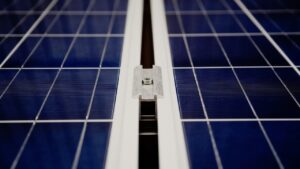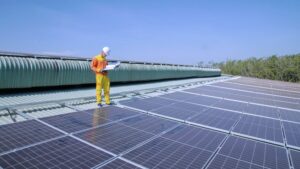As momentum builds worldwide to tackle climate change and decarbonize the transportation sector, global ports and harbors are increasingly focused on reducing their environmental impact. A key priority is enabling ships that call at their terminals to turn off their auxiliary engines while docked and plug into clean shoreside electricity.
This practice of providing onshore power supply (OPS), also known as cold ironing or alternative maritime power (AMP), significantly reduces harmful emissions from ships while berthed. Implementing suitable OPS infrastructure and capabilities represents an essential step for port seeking. This is to improve local air quality, shrink their carbon footprints, and also enable sustainable shipping.
However, integrating OPS into port infrastructure and operations requires navigating a range of equipment options, electrical demands, regulations, construction considerations, and other challenges. Furthermore, ports worldwide stand to benefit from detailed guidance. This is on best practices for planning and executing successful OPS projects.
This comprehensive guide aims to equip ports and harbors with in-depth information on how to strategically implement OPS capabilities and infrastructure to maximize return on investment while delivering multifaceted environmental and operational benefits. It provides a complete reference. So, it encompasses OPS technologies, facility considerations, planning factors, costs, challenges, and solutions.
Let us explore all key aspects of OPS for ports and harbours to help ports chart a course toward sustainable onshore power capabilities that allow for cleaner, quieter, and healthier operating environments.
What is OPS/Cold Ironing?
Onshore power supply, or OPS for ports and harbours, enables docked vessels to plug into land-based power grids to meet onboard electricity needs. This allows ships to shut down their auxiliary engines while berthed, eliminating exhaust emissions at the dock.
The term “cold ironing” originated years ago when ships were coal-powered. So, when the iron engines cooled down, it demonstrated the ship was deactivated. Now, cold ironing and OPS for ports and harbours refer to providing shoreside electrical power to a ship at berth.
OPS for ports and harbours is also sometimes referred to as alternative maritime power (AMP) or shoreside power. Moreover, the technology allows ports to offer clean shoreside electricity to vessels at berth. It is an alternative to running onboard diesel generators.
Key Benefits of OPS for Ports And Harbours
Implementing OPS for ports and harbours delivers several important benefits:
- Eliminates ship exhaust emissions at berth – By enabling auxiliary engines to be turned off, OPS eliminates NOx, SOx, PM, and CO2 emissions at the dock. As a result, this significantly reduces a port’s overall emissions footprint.
- Improves local air quality – Eliminating ship auxiliary engine use at berth improves air quality in and around ports. As a result, it provides health benefits to port workers and nearby communities.
- Enables ships to meet emissions regulations – OPS for ports and harbours helps ships comply with increasingly strict air emission regulations while docked. So, examples include EU regulations and Emission Control Areas.
- Reduces noise – With auxiliary engines off, OPS delivers quieter conditions around ports. This creates a better environment for port workers and residents.
- Provides grid reliability – Modern OPS systems can offer frequency stability and other grid reliability services by leveraging ships as grid assets.
- Facilitates renewable energy use – OPS for ports and harbours infrastructure positions ports to tap into renewable shoreside energy generation, enabling further emissions reductions.
Implementing OPS capabilities delivers multifaceted benefits for both ports and the ships they serve. Moreover, technology plays a key role in reducing shipping’s overall environmental footprint.
OPS For Ports And Harbours: Key Electrical Infrastructure Considerations
Delivering shoreside power to docked ships requires specialized electrical infrastructure tailored to meet OPS demands. So, key factors ports must consider include:
Power Levels
Today’s ships require power levels from 1 to 16 MW, depending on size and purpose. Container ships generally need 4-16 MW, cruise ships around 4-8 MW, and ferries 1-4 MW.
OPS infrastructure must be designed to supply adequate, reliable power within this range. Additionally, voltages from 6.6 to 11 kV are common.
Grid Interconnection
Interconnecting OPS systems with local electric grids is complex, involving transformers, switching gear, protective relays, and monitoring equipment. Moreover, deep expertise in marine shoreside power integration is required.
Power Delivery Architecture
Various architectures exist for routing power to berths, including radial systems, open-ring systems, and closed-loop systems. So, ports must determine the optimal architecture based on layout, reliability needs, and redundancy requirements.
Monitoring & Control
Robust monitoring and control systems are required to enable remote control, automation, and visibility into OPS performance. Advanced systems leverage technologies like smart meters and internet-of-things sensors.
Efficiency
High-voltage shoreside power enables reduced line losses compared to ships’ onboard power. Variable frequency drives and other technologies can further optimize OPS efficiency. Energy storage can absorb spikes in demand.
Cybersecurity
Like all grid-connected systems, cybersecurity protections must be implemented to harden OPS infrastructure against hacking risks. Ports require robust defenses to prevent disruptions.
Careful consideration of these and other factors is essential for designing and building OPS infrastructure tailored to a port’s layout, power needs, and future growth.
OPS For Ports And Harbours: Equipment & Technology Options
Selecting the right OPS equipment and technologies is key to building an optimal system. So, key options to evaluate include:
Cables/Connectors
Shore cables and ship connectors represent a literal connection between shoreside OPS infrastructure and onboard ship systems. High-power cables up to 33 kV are needed to avoid energy losses. As a result, standardized, flexible, high-voltage connectors are essential.
Transformers
Step-up/step-down transformers adjusted via tap changers adapt to supply and demand voltages for efficient power transfer between shore and ship. Furthermore, ultra-compact designs with moisture protection suit port environments.
Switchgear
Switchgear safely conveys shoreside power to ships and isolates electrical equipment for maintenance. Switches, fuses, circuit breakers, and relays are integrated to optimize control and protection.
Automation & Control
Industrial automation and control systems enable remote monitoring, switching, and optimization of OPS equipment. Moreover, networks of sensors, meters, and actuators are integrated with data dashboards and analytics.
Energy Storage
Battery storage systems help absorb demand spikes, provide backup power, and enhance grid stability. Containerized lithium-ion batteries offer compact, modular storage tailored to OPS applications.
Safety Systems
Shoreside safety systems like insulation monitors continuously verify end-to-end insulation from grid to ship. Furthermore, quick breakers and ground indicators help prevent electric shock incidents at berth.
Service & Support
Manufacturer support for installation, commissioning, maintenance, and optimization helps ensure maximum uptime and return on OPS investments. Remote monitoring and diagnostics enable proactive maintenance.
Selecting proven, purpose-built OPS technologies and working with experienced OPS integrators is instrumental in constructing reliable, efficient systems with maximum cybersecurity protections.
OPS For Ports And Harbours: Planning Considerations
One must carefully plan to ensure OPS capabilities are tailored to a port’s layout, vessel traffic, electric infrastructure, and business objectives. So, key planning factors encompass:
Berth Analysis
Which berths should offer OPS? Factors include typical vessel types at each berth, shore access, shoreside power availability, construction feasibility, and usage rates. So, prioritizing OPS-capable berths can provide fast ROI.
Power Capacity Needs
Required power levels depend on the vessel mix. Container ships may need 8-12 MW, while ferries require just 2-4 MW. Scaling capacity to adequately serve all port users is key, with the ability to expand as needs increase.
Utility Upgrades
Bringing multi-megawatt OPS capacity to port often requires utility upgrades like new substations, distribution lines, and transformers. Moreover, early engagement with the utility is critical to enable necessary upgrades.
Construction Factors
Shore access, underground utilities, soils, water table depth, seismic considerations, and footprint availability all impact OPS construction options. Moreover, early geotechnical surveys inform designs.
Operational Impacts
Adding OPS may require changes to port and terminal operating procedures. For example, scheduling the use of OPS-equipped berths, connecting/disconnecting cables, and integrating OPS billing into port systems.
Permitting & Regulations
Permitting, environmental reviews, and inspections are required when constructing OPS facilities. OPS equipment must also meet national electrical and safety codes, which may vary by country.
Proactive OPS planning that engages stakeholders, navigates regulations and secures necessary utility upgrades ultimately enables smooth, cost-effective project delivery.
OPS For Ports And Harbours: Estimating Costs and ROI
Onshore power supply represents a major infrastructure investment for ports. However, costs are offset by significant emission reduction benefits. Key cost factors include:
Construction
Constructing shoreside OPS For Ports And Harbours substations and cable management systems requires civil works and specialty marine electrical construction expertise. Furthermore, cost scale with power capacity needs.
Equipment
The main equipment costs include cables, switchgear, transformers, connectors, and automation systems. Larger capacity needs require more equipment.
Design & Engineering
Detailed system design and engineering require specialized marine shoreside power expertise. So, M=more complex port layouts impact costs.
Permitting & Installation
Securing construction permits and managing proper field installation adds costs. Utility upgrades may require separate permitting.
Operation & Maintenance
Ongoing costs include utility power supply, routine OPS equipment maintenance, and IT/controls support. However, automation enables efficiencies in port operations.
While costs can reach several million dollars depending on project scope, ports can realize substantial ROI by attracting ships that value sustainable berthing. Further ROI accrues from energy savings and emission reductions. Intangible benefits like improved air quality and community perception also hold significance.
OPS For Ports And Harbours: Challenges and Mitigation Strategies
Despite its clear benefits, OPS adoption faces several challenges that ports must plan for:
High Upfront Costs
The upfront capital investment for OPS can deter some ports. So, starting with one berth demonstrates benefits and builds the business case for expansion.
Lack of Standardization
Variations in voltages, shipside plugs, and safety systems complicate OPS. Global standards enable smoother installations and ship compatibility.
Inadequate Grid Infrastructure
Older ports often lack sufficient shoreside capacity and infrastructure to meet OPS power demands. As a result, utility upgrades take planning.
Construction Impacts
Installing cables and OPS equipment can disrupt port operations. Careful construction staging minimizes interference with port business.
Ship Retrofit Requirements
Many ships lack standardized OPS plugs and converters to utilize shore power. Ports can stipulate OPS compatibility in lease agreements.
Cybersecurity Risks
Connecting ships to port grids introduces potential cyber vulnerabilities. Robust network security protections safeguard OPS systems.
Perception of High Costs
Some view OPS as too costly despite significant ROI from energy savings and emissions reductions. Demonstration pilots prove OPS benefits.
With proper planning and engineering, ports can overcome these hurdles and seamlessly integrate OPS capabilities into port infrastructure and operations. Strategic planning for OPS solutions includes tailoring them to each port’s parameters while following common principles. These include:
- Conducting feasibility assessments of grid capacity, space requirements, layout factors, and vessel compatibility
- Starting with smaller pilot projects to demonstrate benefits and build the business case
- Engaging with port users like carriers and terminals to ensure OPS meets operational needs
- Partnering with utilities early to enable necessary grid upgrades and interconnections
- Working with standardization bodies to maximize system interoperability
- Using modeling and simulations to optimize designs and staging
- Exploring available incentives and funding mechanisms to improve project economics
- Implementing cybersecurity best practices throughout planning and installation
- Considering future expansions and grid evolution in initial designs
By proactively addressing key planning factors, ports can develop and execute OPS projects that maximize ROI, whether deploying capabilities at select berths or implementing comprehensive systems.
The Path to Net Zero Ports and Harbours
As momentum builds to decarbonize the global shipping industry, ports, and harbors play a vital role in providing zero-emission berthing for ships. Implementing robust OPS capabilities is a core strategy for eliminating emissions while ships are in dock.
By leveraging the strategies and knowledge provided in this guide, port directors and managers can chart a course toward efficient OPS integration that maximizes ROI while advancing their net zero ambitions. The Net Zero Ports And Harbours is a summit that fits perfectly if you want to head towards your net zero goals. The summit takes place in Barcelona, Spain on 14-15th March 2024.
It will be graced by some of the top experts in the world who will discuss topics like OPS for ports and harbours, Marine vessel electrification: Who is doing what around the globe, Developing and operating ports/harbors for the maritime energy transition, Storage and safety levels of different alternative fuels, Electricity charging infrastructure, Energy storage and more. So, this is the perfect opportunity to be ahead in the revolution while being extremely profitable. Know more about the event and reserve your seat now!





